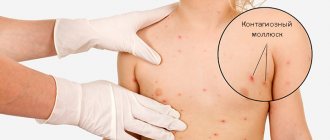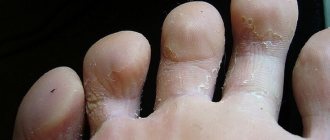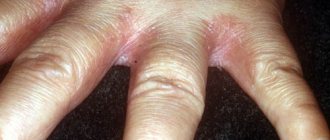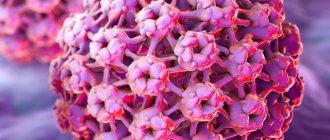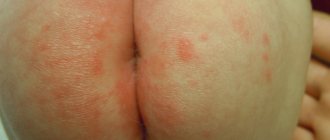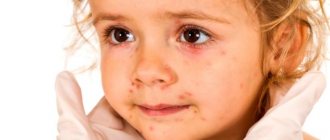Molluscum contagiosum in children is a viral infectious skin disease. The causative agent belongs to the group of Poxviruses, like the variola virus. The virus affects people with weakened immune systems and children aged 2–10 years (preschoolers are most often affected). In most cases, the disease resolves on its own within 6–24 months. The exception is patients with HIV and atopic dermatitis. In them, the disease tends to recur and is more severe; it is necessary to treat the underlying disease.
Causes and routes of transmission
Molluscum contagiosum virus (MCV) affects only humans and is highly infectious. The virus is transmitted from sick people through direct bodily contact or through household items - towels, toys, washcloths, things.
Most often, infection occurs through contact in children's groups - in kindergarten or at home among family members. The virus spreads when visiting sports sections or swimming pools. To stop the spread of the virus, it is recommended to isolate sick children. From the moment of contact with the virus until the rash appears, it takes from 2 weeks to 6 months.
In adults and adolescents, the infection is also transmitted sexually. Infection occurs with a type 2 virus, and the localization of the rash corresponds to the site of penetration of the pathogen - the skin and mucous membranes of the external genitalia, pubis, thighs, perineum.
Scratching the skin promotes infection, so people with atopic dermatitis and other skin diseases are at higher risk of infection. The presence of cracks makes it easier for the virus to penetrate the skin; rashes often appear linearly, as you scratch.
Rare cases of molluscum infection have been observed during tattooing, as well as from an infected mother to her child during childbirth.
Rapid spread to new areas of the skin, a protracted recurrent course, and high susceptibility to viral infection are observed in persons with HIV and against the background of other diseases that weaken the immune system.
Redness and dryness in a child's hands
Dryness and flaking are formed as a result of ichthyosis; this disease is a hereditary disease. Redness with dryness mainly occurs in the folds of the arms. May spread throughout the body.
You might be interested! Spots on the skin of the body that look like lichen: what could it be?
The skin of a child is very sensitive to external factors. The appearance of dryness and redness can be caused by hard water, frequent bathing, insufficient or improper care.
Pathogenesis
Molluscum on the skin of a child is caused in 75–96% by the first type of MCV-1 virus. The causative agent of the disease penetrates the cells of the epidermis. From the viral DNA molecule, the cell begins to synthesize a pathological protein, which soon overflows the cell’s cytoplasm. The cell stretches and takes on a spherical shape; it is called a molluscan body. Increased proliferation and degeneration of cells of the spinous layer of the skin occurs.
At the site where the virus entered, a flesh-colored nodule appears, with unchanged skin around it. The formation grows, takes the shape of a hemisphere or ball, and in classical cases, a depression in the form of a “navel” appears at the top. The papule is filled with whitish contents and resembles a “pearl” due to the accumulation of mollusc bodies. If you press on the element, white crumbling masses appear in the center, similar to “cottage cheese”. These masses contain a lot of viral material, so they can cause the virus and rash to spread over the surface of the skin, infecting other people.
Classification and stages of development of molluscum contagiosum
Molluscum contagiosum in children can affect one anatomical area (localized form), several or the entire body (generalized form). Most often, skin rashes occur on the face, eyelids, torso, and limbs. The exceptions are the palms, soles and scalp; skin lesions are not affected by the mollusc on them.
In addition to the classic form of molluscum contagiosum, atypical forms are found in children. They are more difficult to diagnose, since in appearance the rashes resemble another disease:
- Pedicular molluscs are similar to papilloma; the formation hangs on a thin stalk.
- Giant papules reach 2–3 cm in size; their accumulations can disfigure the face and body.
- Keratinating ones look like warts, covered with horny scales. They are most often located on the back of the hands, between the fingers.
- On the face, papules with white contents resemble acne.
- The cystic form of molluscum in a child is characterized by the formation of a cavity in the middle of the papule.
- Ulcerative form - with it there are skin defects that form in place of nodules and papules.
Allergies
Allergic pathologies also quite often lead to various rashes appearing on clean and healthy children's skin. This is caused by various allergens that enter and affect the body. Quite often, the development of skin rashes is promoted by various chemicals, household chemicals and cosmetics, as well as foods that the child eats daily.
Allergic rashes can occur on the hands and feet, as well as on other areas of the skin. As a rule, they are accompanied by severe itching. Its intensity may vary. In some cases, severe itching of the skin brings severe discomfort to the child. It can occur in a child not only during the day, but also at night.
Body temperature in this case may remain within normal limits.
Symptoms
The disease manifests itself only as skin symptoms, there are no disturbances in the general condition, there is no feeling of well-being, the temperature is normal. The main symptom of molluscum contagiosum in children and adults is a typical, round, pearl-colored rash, painless, against the background of healthy skin or during scratching.
The size of the nodules is from 2 mm to 5 mm, rarely reaching 1.5–2 cm. They can be single or multiple, do not merge, and do not cause itching. The consistency is soft and painless. The number of rash elements is most often up to 20 pieces, but there may be more of them against the background of ARVI, stress, or decreased immunity.
The virus itself does not cause inflammatory changes. If there is swelling or hyperemia around the elements, these are signs of a secondary infection - streptococci, staphylococci, fungi. Also in this case, purulent pustules, pain, and itching appear.
The main discomfort from a molluscum contagiosum rash in children is psychological due to a cosmetic defect. This is especially true for forms localized on the face and multiple papules. Also, the child is restricted from visiting the group, so adults are required to respond and cure the pathology.
What does redness in a child's hands mean?
Often, red spots on the hands of children occur due to allergic reactions . Spots can occur due to the development of infections or skin infection with a fungus. They may indicate the development of a chronic disease.
Rashes may appear after the baby has suffered stress or overwork. The spots may disappear on their own after the child rests. You shouldn't rule out bites from various insects.
The reasons can be varied, which is why you should not try to get rid of it yourself without consulting a doctor. Medicines taken inappropriately can cause significant harm to a child's body.
Previously, the site discussed what to do when a spot on the skin itches.
Diagnostics
The main type of diagnosis of the disease is examination of the skin by a specialist. A pediatric dermatologist visually determines the presence of characteristic rashes, stage, severity and selects treatment. The nature of the pathogen can be confirmed by PCR, but this is usually not necessary. In complex diagnostic cases, the following is carried out:
- Dermatoscopy – examination of the patient’s papules through a magnifying lens.
- Scraping and examination of the contents under a microscope.
- If localized in the anogenital zone, adult patients are tested for HIV and STDs.
- In severe cases, immunological tests are performed to identify hidden immunodeficiency.
Prickly heat
Miliaria can also cause various bright red rashes to appear on the delicate skin of babies. Usually this pathology occurs in children aged 1-2 years. In this case, severe overheating of the baby leads to the development of unfavorable symptoms. Excessively wrapping a child and wearing a jacket or woolen blouse that is too warm can cause characteristic rashes to develop on the hands or inside of the arms.
READ ALSO: What is Fukortsin solution used for - indications for use, instructions, analogues
Symptoms of heat rash, which develops mainly in infants, can be not only in the area of the palms. They also appear in children on their legs, arms and back. Localization depends on what caused the development of prickly heat in children. These manifestations are formed in places of direct contact with warm clothing.
Treatment of molluscum contagiosum in children
In the treatment of molluscum contagiosum in children, two directions can be distinguished - general strengthening of the immune system and local impact on the elements of the rash for the purpose of destruction.
Removal of papules with molluscum on the body is carried out using the following methods:
- Surgically, the contents are scraped out with a sharp spoon or curette and treated with an antiseptic. The method is not used when papules are localized on the face and genital area, or with atopic dermatitis. The advantage of the method is that the material can be examined after removal in a histological laboratory.
- Gentle methods of treatment are cauterization with laser, liquid nitrogen (cryodestruction), electric current (electrocoagulation), and radio waves. After exposure to high or low temperatures, the affected skin cells die. After removing the nodules, a scar remains on the skin. Subsequently, there may be a depigmented or pigmented spot. The best cosmetic effect is observed when exposed to laser, radio waves, and electrocoagulation. Laser and electrocoagulation can treat large areas of skin with multiple rashes. During cryodestruction, the papule is exposed to liquid nitrogen; repeated cauterization may be required to completely destroy the lesion. If necessary, local anesthesia is administered, and after treatment, the skin is thoroughly treated with an antiseptic.
- A conservative method of therapy is a chemical effect on the papules; 5–10% potassium hydroxide is often used. It is applied 3 times a week for a long time (until the effect occurs). Do not use the ointment near the eyes or if the mucous membranes are affected, in children under two years of age. Trichloroacetic acid in the form of peeling, salicylic acid as a gel or patch, silver preparations, iodine, and retinoids can also be used.
If the patient has a generalized form or HIV-positive status, systemic therapy with antiviral drugs according to special regimens (interferon alpha, antiretroviral drugs, cimetidine) is indicated.
The doctor will advise the optimal method of removal depending on the patient’s age, location, extent of the process, and immune status.
Prognosis and prevention
Children with a normal immune system have a favorable prognosis, recovery occurs within six months to two years. In many countries, the tactics for molluscum in a child are watchful and do not provide treatment. To relieve the psychological discomfort of the patient himself and reduce the risk of infection and spread of infection to surrounding people, treatment should be carried out.
Prevention of the disease includes nonspecific methods, that is, it is directed against many pathogens, and not just against the mollusk virus:
- Wash your hands with soap after visiting public places.
- Do not use another person's personal belongings.
- Strengthen the immune system - exercise, eat a varied diet, treat acute and chronic diseases.
- Avoid sexual intercourse during adolescence, have a permanent partner as an adult.
It’s easy to get an appointment at the Miracle Doctor clinic - leave a request on the website or call. At a time convenient for you, the doctor will consult, examine the child, conduct additional diagnostics, and give recommendations.
It is dangerous to treat molluscum contagiosum in children on your own. The use of alternative medicine methods can lead to chemical burns of the skin, the addition of a purulent infection and the spread of the virus over large areas. It is especially dangerous to remove foci of molluscum contagiosum by squeezing at home without observing the principles of asepsis and antiseptics. Removal of elements should only be carried out in the clinic.
Redness and peeling on a child's hands
The baby’s hands turn red and peel due to various ailments:
- Scabies is a disease caused by a mite (scabies), which cannot be seen with the naked eye. Initially, small red spots appear that are very itchy. When scratching, gray lumps form, the damage to which becomes crusty and peels off.
- Epidermophytosis (fungus) of the hands may occur , and a large number of clear red spots appear on the hands, they are very itchy. On the surface of the palms, keratinization and peeling of the skin occurs.
- Secondary syphilis manifests itself as spots not only on the hands, but also on other parts of the body. The rash is round, occupies small areas of the body, and the spots are subject to peeling. With this disease, the patient does not have burning or itching.
- For eczema The child develops spots with a bright outline that flake and itch. Initially, bubbles form, and then a crust. The disease is expressed in malaise and loss of appetite. The itching intensifies during sleep, and the child begins to scratch intensely, which can lead to infection. The following factors may be the reason:
infection; - viruses;
- vitamins (excess, deficiency);
- medicines;
- food allergies.
- Lupus (red) occurs due to disorders associated with the functioning of the immune system. Spots form on the neck, shoulders and arms. They are red and irregular in shape. It is almost impossible to detect the disease in its early stages. This disease cannot be completely cured; it affects internal organs, and it can only be identified after a complete diagnosis.
